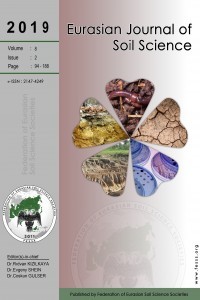
Eurasian Journal of Soil Science
Yazarlar: Dinesh KHADKA, Sushil LAMİCHHANE, Rita AMGAİN, Sushila JOSHİ, Shree P. VİSTA, Kamal SAH, Netra H. GHİMİRE
Konular:Fen
DOI:10.18393/ejss.566551
Anahtar Kelimeler:ARS,Jumla,Ordinary kriging,Soil fertility maps,Soil testing,Sustainable soil management
Özet: Knowledge about the soil fertility status and mapping their spatial distribution play a crucial role for sustainable planning of particular area. Thus, a study was conducted to assess the soil fertility status of the Agricultural Research Station, Bijayanagar, Jumla, Nepal. The farm is situated at the latitude 29.273656°N and longitude 82.180967°E as well altitude 2370masl. The total 18 samples were collected randomly at a depth of 0-20 cm by using soil sampling auger. A GPS device was used for determination of geographical position of soil sampling points. The collected samples were analyzed following standard analytical methods in the laboratory of Soil Science Division, Khumaltar. The Arc-GIS 10.1 software was used for the soil fertility distribution mapping. The observed data revealed the structure was sub-angular blocky, whereas colour were dark grayish brown and very dark brown. The sand, silt and clay content were ranged 27-47%, 33.10-61.10% and 11.90-23.90%, respectively and categorized loam and silt loam in texture. The soil pH was moderately acidic to moderately alkaline (5.45-7.66) and very low in available boron (0.01-0.28 mg/kg) and sulphur (0.59-6.23 mg/kg). Moreover, very low to very high available iron (15.90-300.50 mg/kg), very low to high available manganese (1.46-12.88) and low to high organic matter (2.07-6.53%). Similarly, medium to high total nitrogen (0.14-0.23%), available potassium (40-255 mg/kg) and zinc (1.12-8.26 mg/kg). Correspondingly, high available calcium (1632-2880 mg/kg) and magnesium (98-456 mg/kg), and very high available phosphorus (64.2-257.2 mg/kg) and copper (2.58-12.16 mg/kg). The determined soil test data can be used for sustainable soil management as well as developing future research strategy in the farm.